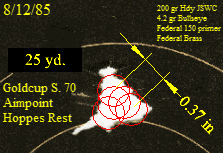Seating Depth = Bullet Length + Case Length - COL
From that formula you can figure the seating depth of published loads
if you have the bullet length. Often you don't, and this is one reason published loads are often applicable only to the bullet used, and not automatically to other bullets the same weight. The JBM site has a
length database that includes some pistol bullets, but it is far from complete. Once you have the bullet length, though, and find the seating depth for a known good bullet, you can then rearrange that same formula to learn what COL you would need for another, different length bullet to give it the same seating depth:
COL = Bullet Length + Case Length - Seating Depth
So now the complications:
The new COL might not chamber because a stubbier bullet seated out will present its ogive closer to the lands.
Using the same seating depth does not make for same jump to the lands, so it's not a given that the pressures will match.
A bullet that makes a longer jump to the lands may reduce pressure despite matching seating depth. This is not a factor QuickLOAD has an argument for.
A bullet designed for a magnum revolver may have a thicker, harder jacket than one for 9 mm. That could raise pressure a bit. Check the manufacturers range of usage velocities for a quick compare. Faster normally means a thicker or harder bullet, but asking the maker is best.
Using a bullet 0.002" bigger in combination with brass that is on the thick side will jam in some chambers. You want to be doubly careful that there is still a little clearance for the case to let go of the bullet. 0.0005" will do, but you may need to use a slug or a chamber cast to be sure how much is available to you.
Then, in the end, you are back to load work-ups as the final step in determining the safety of the load.
In the 70's or 80's I spent $50 on a surplus French police MAB. .32 ACP. The jacketed commercial bullets are 0.311. The bore was 0.309". Firing oversize is not particularly unusual. Almost all the SAAMI specs have the maximum bullet diameter 0.001" over nominal groove, and the grooves can be smaller than nominal by another 0.001", though there is a minimum groove cross-sectional area, and that is affected by different land configurations as well as bore and groove diameters.
As to it being more accurate, in cast lead bullets it is often so. This has to do with the fact they are easily swaged to an off shape in a throat and no gas leaks can be allowed if accuracy is to hold up. I've not noticed oversize being more accurate with jacketed bullets, particularly. Among rifles, most Palma match barrels are on the tight side, but the purpose there is maximizing velocity to stay supersonic as far as possible. British rifle competitors used to swear by the accuracy of their .309" groove barrels. So, for jacketed bullets, I just don't see the advantage, especially not in a pistol, a device for which a 4 moa group is considered darn good and fully competitive on 50 yard targets.
The 25 yard 5-shot group below was shot with 0.451" bullets in a barrel that was 0.451" across one diagonal and 0.4515" across the other. Not even round. Jacketed bullets seem to handle of bit of oddness remarkably well.

